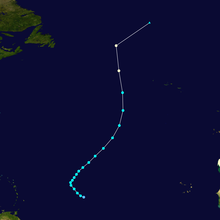Hurricane Lisa (1998)
| Category 1 hurricane ( SSHWS ) | ||
|---|---|---|
| Hurricane Lisa in the northern Atlantic | ||
| Emergence | 5th October | |
| resolution | 9th October | |
|
Peak wind speed |
|
|
| Lowest air pressure | 995 mbar ( hPa ; 29.4 inHg ) | |
| dead | no | |
| Property damage | no | |
|
Affected areas |
on the high seas | |
| Season overview: 1998 Atlantic hurricane season |
||
Hurricane Lisa was the twelfth tropical cyclone of the 1998 Atlantic hurricane season . The storm developed from a tropical wave that broke off the West African coast on September 29. By October 4, a near-surface circulation had formed and by the morning of October 5 it was classified as tropical; In the course of the day, it was upgraded to a tropical storm. Initially pulling in a northwest direction, Lisa turned northeast and then accelerated north. The storm turned into a hurricane before the transition into an extra-tropical system over the cold waters of the northern Atlantic . Since Lisa stayed far from land, there are no reports of damage.
Storm course
A tropical wave that drifted from the west coast of Africa into the Atlantic Ocean on September 29th organized itself well and developed heavy cloud cover. The next day, however, the system came under the influence of the intra-tropical convergence zone . It wasn't until October 3 that the system became more recognizable when the convection increased. The first signs of a near-surface circulation appeared on October 4th, when the low pressure area was about halfway between Africa and the Lesser Antilles . It is believed that the system became a tropical depression on October 5th at 0:00 UTC .
Initially, the low pressure area was poorly organized, as it was exposed to strong wind shear due to a low pressure area at high altitude in the northwest of the storm system . The western half of the circulation was separated from the convection area, while deep convection persisted in the eastern half. On October 5th, the system had intensified so much that it was upgraded from the National Hurricane Center to Tropical Storm Lisa; the operational reports indicated that it had reached the strength of a tropical storm eighteen hours earlier. The same low pressure area that had previously created the wind shear created a weakness in a high pressure ridge to the north of the storm, causing the storm to move north. Due to the wind shear, it seemed unlikely at the time that Lisa would intensify any further. Lisa had a relatively large circulation and was therefore more resistant to wind shear than cyclones with a smaller circulation. During the morning of October 7th, the center of circulation was always near the strongest convection. A measuring buoy nearby reported wind speeds of almost 110 km / h, which indicated that the sustained wind speed was around 95 km / h. A strong baroclinic trough shifted over a severe depression over the central North Atlantic, forcing Lisa to turn in a northeasterly direction.
Early on October 8, the storm appeared better defined on satellite images. During the day there was thunderstorm activity near its center and band structures developed, both signs of intensification. This was attributed to the weaker wind shear or the influence of the trough. In addition, the storm was trying to form an eye . Lisa sped away in a northeasterly direction on the afternoon of October 9th at a forward speed of more than 90 km / h. Due to the low pressure area in the west and a high pressure system in the east, the migration direction turned more to the north. At 12:00 UTC, the storm hit Category 1 on the Saffir-Simpson Hurricane Wind Scale . Shortly afterwards, the storm over the cold waters of the northern Atlantic lost its tropical properties and turned into an extra-tropical storm. It connected itself to an extra-tropical front system and on October 10th no well-defined circulation was recognizable.
Impact and naming
Because Lisa stayed far from the country, no damage to property or life was reported. No ships were affected and no storm warnings were issued. It was the first time the name Lisa was used in the Atlantic for a tropical storm. With no impact on land, the name was not removed from the list of tropical cyclone names , but reassigned in 2004 and is also on the list as used during the 2010 hurricane season.
Individual evidence
- ↑ a b c d e f g Miles B. Lawrence: Hurricane Lisa Tropical Cyclone Report ( English ) National Hurricane Center. 1998. Retrieved November 7, 2008.
- ↑ Lawrence: Tropical Storm Lisa Discussion Number 1 ( English ) National Hurricane Center. 1998. Retrieved November 7, 2008.
- ^ Pasch: Tropical Storm Lisa Discussion Number 2 ( English ) National Hurricane Center. 1998. Retrieved November 7, 2008.
- ↑ Avila: Tropical Storm Lisa Discussion Number 8 ( English ) National Hurricane Center. 1998. Retrieved November 7, 2008.
- ↑ Mayfield: Tropical Storm Lisa Discussion Number 11 ( English ) National Hurricane Center. 1998. Retrieved November 8, 2008.
- ↑ Avila: Tropical Storm Lisa Discussion Number 12 ( English ) National Hurricane Center. 1998. Retrieved November 8, 2008.
- ↑ Avila: Tropical Storm Lisa Discussion Number 13 ( English ) National Hurricane Center. 1998. Retrieved November 8, 2008.
- ↑ Avila: Hurricane Lisa Discussion Number 17 ( English ) National Hurricane Center. 1998. Retrieved November 8, 2008.
- ↑ Worldwide Tropical Cyclone Names ( English ) National Hurricane Center. 2007. Retrieved February 19, 2008.


